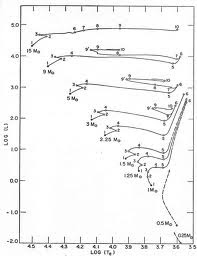 One thing that, until now, I haven’t mentioned is another important process that occurs in stars and allows for another important set of tests for stellar evolution. That process is convection. For various masses of stars, convection occurs at different places in the star. In our own sun, we know this occurs on the surface. We can see this in the form of granules (from SVST).
One thing that, until now, I haven’t mentioned is another important process that occurs in stars and allows for another important set of tests for stellar evolution. That process is convection. For various masses of stars, convection occurs at different places in the star. In our own sun, we know this occurs on the surface. We can see this in the form of granules (from SVST).But convection doesn’t always have to occur at the surface. In other stars, convection may occur in the cores, or somewhere in between. In some cases, the whole star may be convective! Convection tends to occur when radiative processes (photons traveling through space) are insufficient to carry the energy of the star towards the surface. This would be due to things such as the density getting sufficiently high that the photons just can’t get anywhere before being reabsorbed or scattered off in a random direction (possibly back towards the center of the star). Another thing models tell us is that the properties which determine how effective radiative transport is, will change over time. This, in turn, means that convection will start and stop at various points throughout the stars lifetime.
When observing stars, it should go without saying that the only thing that we directly observe is whatever is on the surface. Convection is important because it can dig down into the star and bring up material from deeper down, or carry fresh material down closer to the core where temperatures are hotter. In the case of some special elements, this can destroy them.
By comparing these predictions of abundances of elements in various phases of a stars life to observations, we can get another test of on stellar evolution.
The first case, in which different material is brought to the surface, occurs when convection digs deep enough into a star that it encounters a layer in the star’s interior that had previously been subject to fusion. Since fusion creates heavier elements than what would be present on the surface, the convection would make this visible as it brings it up. This process is known as “dredging”.
Dredging may occur at several points after a star leaves the main sequence. The first occurs shortly before the onset of helium fusion in the core of stars while the star is in the red giant phase.
So what we can do is look at stars on the evolutionary tracks I mentioned in the previous post, and compare the ratios of abundances before and after this dredge up phase. What we should see, if the theory is correct, is an increase in certain heavier elements. And not only that, models should also be able to predict, fairly well, how much those ratios should change.
In this first dredge up, one of the most notable changes will be the ratio of C13 to C12. In the second dredge up phase, models predict that there will be increases in He and N content. Sufficiently massive stars should also undergo a third dredge up, in which carbon and oxygen will be brought up.
All of these changes have been confirmed observationally, and within reasonably amounts, they conform to the predicted ratios. As should be expected, some variation is inevitable due to difference in initial abundances.
But, as I mentioned earlier, increasing surface abundances isn’t the only effect that periods of convection should have. Certain elements, if subjected to convection should be destroyed. Lithium is the most prominent in this case.
Since lithium isn’t something that’s readily created, the amount stars start off with is pretty much all they’re ever going to get. Lithium is also fairly easily destroyed at higher temperatures. The surfaces of most stars aren’t quite hot enough to do so, but if lithium is pulled down to depths where temperatures are hotter through convection, then the surface abundance of lithium will be depleted. Again, models predict at what phases in evolution we should begin seeing lithium depletion, and again, they’re reasonably accurate.
So let’s quickly what we’ve discovered in this series thus far: First off, evolutionary models predict where we should and should not see stars on the H-R diagram. They match where they will speed along, and when they’ll clump. In this post, we’ve explored how models also predict and match chemical abundances throughout the evolutionary process.
In future posts, we’ll explore even more tests of these models to ensure that they do indeed conform to reality.















